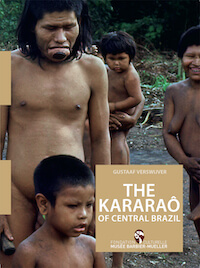
THE KARARAÔ OF CENTRAL BRAZIL by G. Verswijver (2020)
 The Kararaô of Central Brazil
The Kararaô of Central Brazil
By Gustaaf Verswijver
Musée Barbier-Mueller, Genève, 2020
The aim of The Kararaô of Central Brazil is to acquaint people with the Kararaô, a group of Kayapo Indians in central Brazil, who in 2010 numbered only fifty-four, by focusing on their extremely complex history. The name Kararaô is inextricably linked to a hydroelectric dam complex the Brazilian government planned to build in the 1980s on the Xingu River in Brazil. Few know that Kararaô is the name of a small faction of the renowned Kayapo Amerindian people who live in the vicinity of the dam, today called Belo Monte. Unlike the other Kayapo groups (Gorotire, Kubenkranken, Kokraimoro, Mekranoti, Metuktire, and Xikrin) among which anthropologists have done intensive fieldwork, the Kararaô remained unstudied. This can be explained by the fact that anthropologists often prefer to work in bigger villages because these usually have a more thriving political and ceremonial life. Indeed, the Kararaô group no longer celebrates ceremonies and has no functioning men’s house, which are essential features of Kayapo society. As such the Kararaô did not really appeal to anthropologists. The present essay aims to acquaint people with the Kararaô, by focusing on their extremely complex history. The anthropologist Gustaaf Verswijver conducted three years of intensive research on the history of this little-known Kayapo group.
Although the Kararaô did not break away from the other Kayapo groups until the early 1930s, their history is composed of an uninterrupted series of splits and mergers, displacements to escape attacks and massacres, and the disastrous consequences of their increased contact with Brazilian society, which at times they themselves sought. As a result, of the four known Kararaô factions that existed in the early 1940s, only one still survives, the others have become extinct. The present essay not only reflects the Kararaô’s struggle for survival, but it also attests to the Brazilian state’s inability to provide adequate assistance to them before the 1970s.
The book is published in the series of the Fondation Culturelle Musée Barbier-Mueller (Geneva) which was launched to bear witness to forgotten peoples. It is available in English or French edition at the following address https://www.barbier-mueller.ch/en/boutique/publications-of-the-fondation-culturelle-musee-barbier-mueller/the-kararao-of-central-brazil/
About the author
Gustaaf Verswijver is Honorary Curator in the Ethnography Division of the Royal Museum for Central Africa (Tervuren, Belgiu).

